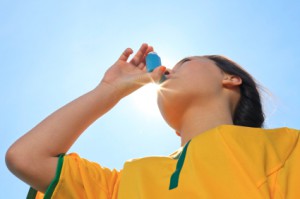Donna Wolf, PhD, is a clinical research coordinator with UVA’s Division of Pediatric Respiratory Medicine, where she conducts clinical trials that test asthma treatments in children and adults. Wolf is also a clinical exercise physiologist. She wrote this post for us about asthma and exercise.
 Asthma is a chronic condition that affects the respiratory system, primarily the airways. It can cause symptoms that range from minor coughing and wheezing to life-threatening attacks; however, asthma is not a reason to avoid exercise.
Asthma is a chronic condition that affects the respiratory system, primarily the airways. It can cause symptoms that range from minor coughing and wheezing to life-threatening attacks; however, asthma is not a reason to avoid exercise.
For many asthma sufferers, physical exertion and vigorous exercise can trigger asthma symptoms. But lack of exercise is not good for anyone, especially patients with asthma who should avoid gaining weight and need the benefits of exercise on breathing. With the right treatment, you can enjoy physical activity while still controlling your asthma.
What is Exercise-Induced Airways Narrowing?
Exercise-induced airways narrowing (EIB) is a narrowing of the airways in response to vigorous activity that disrupts the normally smooth flow of air from the lungs. According to the American Academy of Allergy, Asthma and Immunology (AAAI), most people with chronic asthma have symptoms when they exercise. Others experience EIB even though they do not have persistent asthma symptoms at other times.
Symptoms of EIB include coughing, chest tightness, wheezing and shortness of breath. They generally flare up after 5 to 10 minutes of vigorous outdoors exercise.
Is It Safe to be Physically Active if I Have Asthma?
One of the goals of asthma treatment is to help you maintain a normal and healthy lifestyle, which includes being physically active.
Following an asthma action plan by taking medications as prescribed by your doctor, avoiding your asthma triggers and monitoring your symptoms and lung function will help you achieve this goal. If exercise triggers your asthma symptoms, you can eliminate or reduce it with planning and preventive medications.
The days of protecting and preventing individuals with asthma from taking part in organized sports are essentially a thing of the past, thanks to the overall successful management of the condition through medications and breathing aids, including inhalers.
Physicians want their asthma patients to get active, especially in asthma-friendly activities like:
- Swimming
- Bicycling
- Golf
- Walking
- Weightlifting
Why are these good choices if you want to be physically active?
- They let you control how hard and fast you breathe.
- They let you breathe through your nose at all times.
- They don’t dry out your airways.
- They mix short, intense activities with long endurance workouts.
- You can do them in a controlled environment (for example, a gym with air that’s not too cold or dry).
- Usually you do them with other people, who can help you if you have an attack.
Getting regular physical activity can improve your breathing and lead to fewer asthma attacks. Just remember to follow these tips.
What Should I Do to Control My Asthma When I Am Physically Active?
- Talk to your healthcare provider about using a pre-exercise asthma inhaler (inhaled bronchodilator) about 10 minutes before becoming physically active. Usually this is an inhaler like albuterol. (Tablet medications that block the actions of chemicals called leukotrienes released with exercise can be used in combination with albuterol or taken before albuterol. In special cases, asthma patients who participate in prolonged activity need to take a long-acting bronchodilator instead of albuterol.)
- Ease into it. Start out a new exercise program slowly and work your way up to being able to do 30 minutes most days of the week.
- Perform 5-10 minutes of warm-up exercises and maintain an appropriate cool-down period of 5-10 minutes after exercise. (The first episode of EIB on a given day is usually the worst one.)
- If the weather is cold, exercise indoors or wear a mask or scarf over your nose and mouth.
- If you have allergy-induced asthma, avoid exercising outdoors when pollen counts are high and when there is high air pollution.
- Restrict physical activity when you have a viral infection, like a cold.
- Conduct physical activity at a level that is appropriate for you.
What If I Have an Asthma Attack While Exercising?
If you begin to experience asthma symptoms during exercise, stop and repeat your pre-exercise inhaled medication (like albuterol). If your symptoms completely go away, you may restart the exercise. If your symptoms return, stop the activity, repeat your quick relief medication and call your healthcare provider for further advice.
Communication With Your Healthcare Provider Is Key
With proper diagnosis and the most effective treatment, you should be able to enjoy the benefits of exercise without experiencing asthma symptoms.
To feel your best, do the right things to control your asthma. And listen to your healthcare providers — they’re on your team!
Find out more about asthma and allergy treatment at UVA.


Hi,
I have a quick question about your blog, do you think you could email me?
Jillian
hi thank you for the advice …please email me…cuevas.carlos99@gmail.com..
i have a couple of questions…im a fighter….i love exercise..always been active my whole life but the problem happened recently ..it was winter time and i decided to stop doing cardio..because i was lazy and forgot about my asthma..because my asthma never bothered since i was 7 and i am 15 now…but what happen i got a cold then it went away but i noticed the cough stayed for a couple of weeks and its says in the back of the cold medication box…if the cough persist..for more than 2 week consult your docter…and so i asked my mom if she can take me..but she never did…for about a month and a half.. then i ask my aunty and she finally ..tool me..and the said i had asmatic bronchitis…so he gave me the prescriptions ..and i was going to get them the next day..then my mom lost them…and wouldnt help me get new ones or find the paper so i can get the medicine ..so i continued to workout as usual even with the cough then…i went to mexico to vist my dad for the holidays then once i got here i almost died ..and they gave me antibotic shots and a bunch of medicine..and told me stop working out …so i havent worked out for 2 months and now my bronchitis went away but now i have to deal with my asthma…and it wont go away ..my lungs got weaker..i cant even handle 2 sets of push ups ..with out coughing my lungs out ..and i take my inhaler…and it doest seem to help..so i stop..and put vapor rub on my chest and my back…and in my nose and breathe …in and out and im okay now just i have trouble breathing sometimes…but i really want workout and train again but my lungs cant really handle alot anymore…any advice for me….please email me
cuevas.carlos99@gmail.com
I’m surprised that weightlifting is on the list of activities recommended for those with asthma. I feel like I have a harder time breathing when lifting weights that I do when running. I guess I’m just not breathing right. What kind of preventative medications are there for asthma that is induced by exercise? http://www.aerospanrx.com/
Reading this article has helped me to understand how I should treat asthma. I like how you explained that communication between you and your physician is a good way to treat your asthma. I hope that I can remember this article if I ever start to experience problems with my asthma. http://cookinghamallergy.com/
nice information thank you
To get rid of asthma study acupressure.
Asthma is in fact relatively easily cured with acupressure. Google for
gv26 important.
and see how lip pressure relaxes lung airways. So inhale consciously and mindfully through the nose pulling the lips together and not asthmatically wth mouth breathing in step with breathing and not occaisionally .
Breathe into the belly and keep clear of sprays, if needed with a doctor’s help. Clenching fists also helps using acupressure. See video gimnastika strelnikovoi peredniy shag
In 2016 my sister in-law told us about Rich Herbs Foundation (ww w. richherbsfoundation. c om) and their successfully COPD treatment. We ordered the COPD Formula product after reading positive reviews from other patients who used the treatment, i am happy to report this COPD treatment reversed my lungs condition and damage. My quality of life has greatly improved and every one of my symptoms including difficulty breathing, Chronic cough and wheezing are gone. I will be 52 soon and have never been healthier.